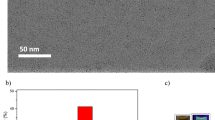Abstract
A new type of covalent bulk modified glassy carbon composite electrode has been fabricated and utilized in the simultaneous determination of lead and cadmium ions in aqueous medium. The covalent bulk modification was achieved by the chemical reduction of 2-hydroxybenzoic acid diazonium tetrafluroborate in the presence of hypophosphorous acid as a chemical reducing agent. The covalent attachment of the modifier molecule was examined by studying Fourier transform infrared spectroscopy, X-ray photoelectron spectroscopy and the surface morphology was examined by scanning electron microscopy images. The electrochemistry of modified glassy carbon spheres was studied by its cyclic voltammetry to decipher the complexing ability of the modifier molecules towards Pb2+ and Cd2+ ions. The developed sensor showed a linear response in the concentration range 1–10 μM with a detection limit of 0.18 and 0.20 μM for lead and cadmium, respectively. The applicability of the proposed sensor has been checked by measuring the lead and cadmium levels quantitatively from sewage water and battery effluent samples.











Similar content being viewed by others

References
Cesarino I, Cavaltheiro EJ, Brett CMA (2010) Electroanalysis 22:61–68
El Mhammedi MA, Achak M, Chtaini A (2009) J Hazard Mater 161:55–61
Viyannalage LT, Bliznakov SB, Dimitrov N (2008) Anal Chem 80:2042–2049
Darwish IA, Blake DA (2002) Anal Chem 74:52–58
Tan MG, Zhang GL, Li XL, Zhang YX, Yue WS, Chen JM, Wang YS, Li AG, Zhang M, Shan ZC (2006) Anal Chem 78:8044–8055
Taher MA (2003) Croatica Chem Acta 76:273–277
Vassileva E, Quetel C (2004) Anal Chim Acta 519:79–86
Wan Z, Xu Z, Wang J (2006) Analyst 131:141–147
Li J, Guo S, Zhai Y, Wang E (2009) Anal Chim Acta 649:196–201
Jena BK, Raj CR (2008) Anal Chem 80:4836–4884
Ramesh P, Sampath S (2001) Analyst 126:1872–1877
Zen JM, Kumar AS, Tsai DM (2003) Electroanalysis 15:1073–1087
Kooi SE, Schlecht U, Burghard M, Kern K (2002) Angew Chem 41:1353–1355
Morton J, Havens N, Mugweru A, Wanekaya AK (2009) Electroanalysis 21:1597–1603
Somashekarappa MP, Sampath S (2004) Anal Chim Acta 503:195–201
Alexander MY, Kuwana T (1978) Anal Chem 50:640–645
Jaegfeldt H, Kuwana T, Johansson G (1983) J Am Chem Soc 105:1805–1814
Xu J, Chen Q, Swain GM (1998) Anal Chem 70:3146–3154
Khan MR, Khoo SB (1996) Anal Chem 68:3290–3294
Motta N, Guadalupe AR (1994) Anal Chem 66:566–571
Pandurangappa M, Ramakrishnappa T (2010) Mater Chem Phys 122:567–573
Wildgoose GG, Pandurangappa M, Lawrence NS, Jiang L, Jones GJJ, Compton RG (2003) Talanta 60:887–893
Yang H, McCreery RL (1999) Anal Chem 71:4081–4087
Pandurangappa M, Lawrence NS, Compton RG (2002) Analyst 127:1568–1571
Boehm HP (1994) Carbon 32:759–769
Ramesha GK, Sampath S (2007) Electroanalysis 19:2472–2478
Pandurangappa M, Ramakrishnappa T, Compton RG (2009) Carbon 47:2186–2193
Abiman P, Crossley A, Wildgoose GG, Jones JH, Compton RG (2007) Langmuir 23:7847–7852
Shams E, Alibeygi F, Torabi R (2006) Electroanalysis 18:773–778
Li Y, Liu X, Zeng X, Liu Y, Wei W, Luo S (2009) Sens Actuators B 139:604–610
Degefa TH, Chandravanshi BS, Alemu H (1999) Electroanalysis 11:1305–1311
Inczedy J (1976) Analytical applications of complex equilibria. Ellis Horwood, New York
Acknowledgments
The authors acknowledge the financial support and award of Junior Research Fellowship (JRF) to GKR by the Department of Science and Technology, New Delhi, India.
Author information
Authors and Affiliations
Corresponding author
Rights and permissions
About this article
Cite this article
Raghu, G.K., Sampath, S. & Pandurangappa, M. Chemically functionalized glassy carbon spheres: a new covalent bulk modified composite electrode for the simultaneous determination of lead and cadmium. J Solid State Electrochem 16, 1953–1963 (2012). https://doi.org/10.1007/s10008-011-1595-1
Received:
Revised:
Accepted:
Published:
Issue Date:
DOI: https://doi.org/10.1007/s10008-011-1595-1



